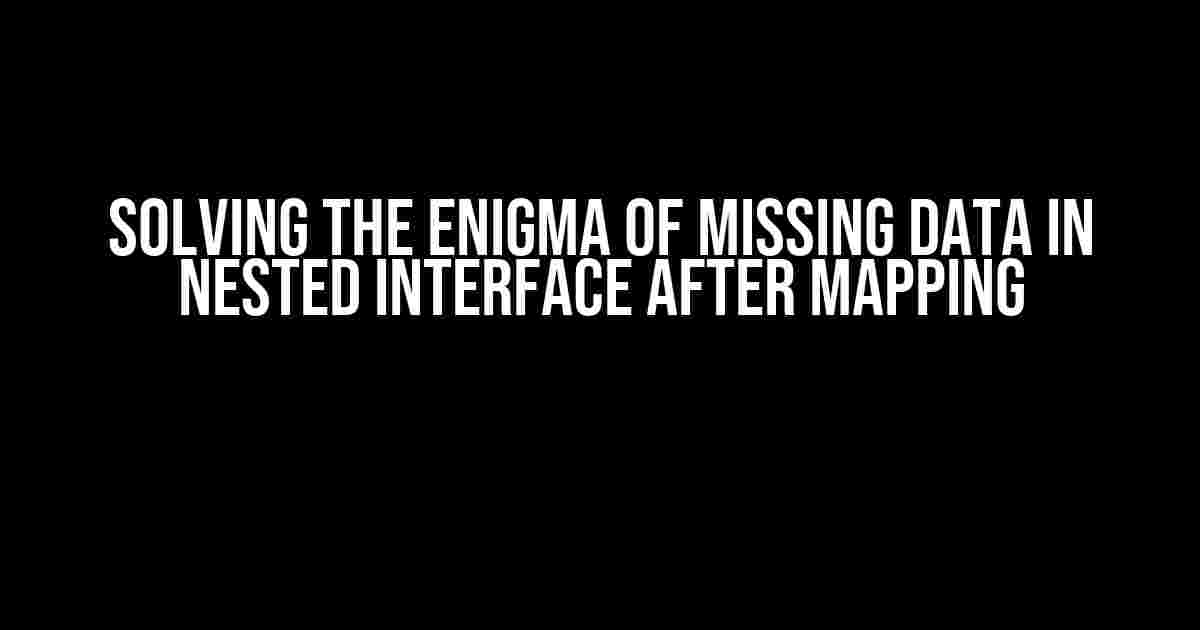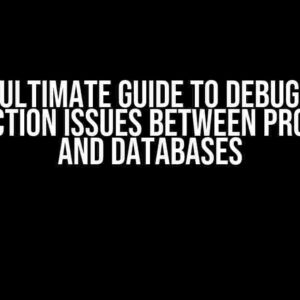Are you tired of banging your head against the wall, trying to figure out why your data is mysteriously vanishing after mapping it to a nested interface? Well, buckle up, friend, because today we’re going to embark on a thrilling adventure to unravel the mystery of missing data in nested interfaces!
What’s the Big Deal About Nested Interfaces?
In the world of programming, nested interfaces are a common phenomenon. They allow us to create complex data structures that mirror real-world relationships. However, when it comes to mapping data to these interfaces, things can get messy. Suddenly, data that was present just a moment ago seems to disappear into thin air! It’s as if the mapping process is playing a cruel joke on us, leaving us wondering what went wrong.
The Usual Suspects: Common Causes of Missing Data
Before we dive into the solutions, let’s Take a closer look at the usual culprits behind missing data in nested interfaces:
- Inconsistent data types: When the data types in your interface don’t match the actual data, it can lead to data loss. Make sure to double-check your type definitions!
- Optional properties: If your interface has optional properties, they might not be initialized properly, causing data to disappear. Be mindful of those question marks!
- Null or undefined values: Ah, the infamous null pointer exception! Make sure to handle null and undefined values with care, lest they devour your data.
- Object references: When objects are referenced instead of copied, changes to the original object can affect the mapped data. Keep an eye on those object references!
Unraveling the Mystery: A Step-by-Step Guide
Now that we’ve identified the suspects, let’s walk through a step-by-step guide to ensure that your data remains intact after mapping to a nested interface:
- Verify data types: Double-check that the data types in your interface match the actual data. Use tools like TypeScript or JavaScript type checking to catch any discrepancies.
- Use the “as” keyword: When mapping data, use the “as” keyword to explicitly cast the data to the correct type. This helps prevent type mismatches and data loss.
- Initialize optional properties: Make sure to initialize optional properties with default values to prevent them from being null or undefined.
- Handle null and undefined values: Use conditional statements or the Optional Chaining Operator (?.) to safely navigate null or undefined values.
- Use object spread or deep copying: When working with objects, use the object spread operator ({ …originalObject }) or a deep copying library like lodash to ensure that changes to the original object don’t affect the mapped data.
Code Snippets: Putting it all Together
interface NestedInterface {
id: number;
name: string;
address?: {
street: string;
city: string;
state: string;
}
}
const data = {
id: 1,
name: 'John Doe',
address: {
street: '123 Main St',
city: 'Anytown',
state: 'CA'
}
}
const mappedData: NestedInterface = {
id: data.id,
name: data.name,
address: data.address as {
street: string;
city: string;
state: string;
}
}
console.log(mappedData);
In the above code snippet, we’ve used the “as” keyword to explicitly cast the address property to the correct type, ensuring that the data remains intact.
Real-World Scenarios: When Things Get Complicated
Sometimes, despite our best efforts, missing data can still occur due to the complexity of the interface or the data itself. Let’s explore some real-world scenarios and how to tackle them:
| Scenario | Solution |
|---|---|
| Complex nested interfaces with multiple levels of nesting | Use a library like immer or json-mapper to handle complex nested structures and ensure data integrity. |
| Dynamic data that changes shape or structure | Implement a data normalization strategy, such as using an ORM or data transformation library, to ensure consistency and prevent data loss. |
| Data from external sources with inconsistent formats | Use data validation libraries like joi or ajv to validate and normalize incoming data, ensuring it conforms to your interface. |
Conclusion: Solving the Enigma of Missing Data
We’ve unraveled the mystery of missing data in nested interfaces! By following the steps outlined in this article, you’ll be well-equipped to tackle even the most complex data mapping scenarios. Remember to verify data types, use the “as” keyword, initialize optional properties, handle null and undefined values, and use object spread or deep copying to ensure data integrity.
With these strategies in your toolkit, you’ll be able to confidently map data to nested interfaces, knowing that your data is safe and secure. No more missing data, no more headaches!
So, go forth and conquer the world of nested interfaces! And if you ever encounter missing data, just remember: it’s not the data that’s the problem, it’s the interface.
Here are 5 Questions and Answers about “Missing data in nested interface after mapping” with a creative voice and tone:
Frequently Asked Question
Get the inside scoop on dealing with missing data in nested interfaces after mapping!
What happens when data goes missing in nested interfaces after mapping?
When data goes missing in nested interfaces after mapping, it’s like losing a puzzle piece – everything falls apart! The issue arises when the mapping process fails to retrieve or assign data correctly, resulting in incomplete or null values. This can lead to errors, inconsistencies, and a whole lot of frustration.
Why do I see null or undefined values in my nested interface after mapping?
The sneaky null or undefined values! They often appear when the mapping process can’t find a matching property or value in the source data. This can happen due to typos, incorrect data types, or simply because the data wasn’t there in the first place. Double-check your mapping configuration, and make sure you’re not dealing with optional properties or empty datasets.
How do I troubleshoot missing data in nested interfaces after mapping?
Time to put on your detective hat! Start by reviewing the mapping configuration, data sources, and target interfaces. Check for any errors or warnings in the mapping process. If you’re using a mapping tool, consult its documentation and logs for clues. You can also try debugging the mapping process step-by-step to isolate the issue.
Can I use default values or fallbacks to handle missing data in nested interfaces?
The art of improvisation! Yes, you can use default values or fallbacks to handle missing data in nested interfaces. This approach can help prevent errors and inconsistencies. However, be cautious when using default values, as they might not always reflect the correct data. It’s essential to weigh the pros and cons and consider the impact on your application.
What are some best practices to prevent missing data in nested interfaces after mapping?
Prevention is the best medicine! To avoid missing data, follow best practices such as defining clear data schemas, using robust mapping tools, and testing your mapping configurations thoroughly. Additionally, consider implementing data validation, normalization, and standardization to ensure consistency and accuracy throughout the mapping process.


